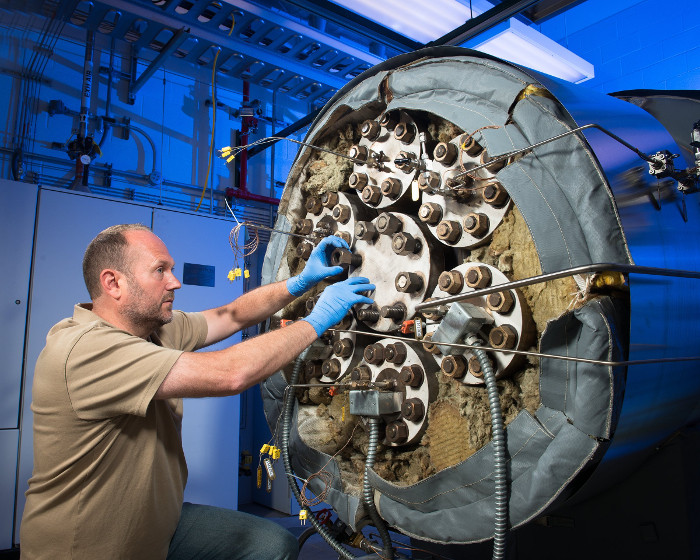NASA simulates Venus's hellish environment
The harsh environment with many of Venus's toxic chemicals is reproduced by laboratory scientists in Ohio, USA.
Scientists at NASA's Glenn Research Center are simulating the surface conditions on Venus in the room called Glenn Extreme Environments Rig (GEER) in Cleverland, Ohio, USA, Business Insider on 8/8 12 reports.
GEER combines all the information researchers have about environmental conditions on the planet's surface. It uses a mixer to combine the gases found on Venus and heat them with a powerful type heater.
"Gas mixes need two and a half days to heat and five days to cool," said Geer chief engineer Leah Nakley.

GEER lab simulates Mars' environment located in Ohio, USA.(Photo: GEER).
According to Gustavo Costa, a chemical and materials scientist, he can learn about Venus's atmosphere using GEER.
"It's not just gas, it's a supercritical fluid mixture , " Costa commented.
Supercritical solutions act like gases and liquids at the same time. Costa said walking on the surface of Venus would feel the same when going through the thick air. It is very hot and has a pressure of pressure at a depth of 100m under water.
"I think it's like you're in a pressure cooker," Costa said.
In addition, Venus's atmosphere carries signs of very dangerous chemicals such as hydrogen fluoride, hydrogen chloride, hydrogen sulfide and sulfuric acid.
"Venus has acid clouds instead of steam clouds. The scary thing is that you have to go through it to reach the planet's surface. The environment here is very harsh, like hell on Earth," Costa describes. .
Since the room began operations in 2014, researchers have experimented with many materials such as metal, ceramic, steel fibers, electroplating and electronics exposed to Venus-like environmental conditions to See their stamina.

Experiment for metal wire exposed to Venus-like environmental conditions.(Photo: GEER).
Their goal was to find a way to build spacecraft that could exist for months, even years on Venus, instead of being destroyed almost immediately.
" Venerra 12 is one of the most recent Venus probes and it only lasts about two hours and 7 minutes because of the highly corrosive environment on Venus , " explains Costa.
Therefore, GEER is the best way for scientists to learn about Venus's environment, before they successfully build spacecraft that can pass through the planet's atmosphere.
- NASA simulates humans living on Mars in the desert more than 50 degrees Celsius
- NASA simulates meteorite on the seabed
- An artificial person's heart simulates cardiac arrest
- Former NASA astronaut participates ... playing in a gravityless environment
- NASA simulates invisible magnetic fields on the Sun.
- Software that simulates human images in the next 80 years
- Excavate and preserve fossil dinosaur skeletons
- Bacteria can live in arsenic environment
- Making an electronic chip that simulates how the brain works
- NASA cooperates with Peru to implement a potato planting project in the Mars environment
- Detailed 3D map of the Moon's surface
- NASA built 'hellfire' on Earth
 Van Allen's belt and evidence that the Apollo 11 mission to the Moon was myth
Van Allen's belt and evidence that the Apollo 11 mission to the Moon was myth The levels of civilization in the universe (Kardashev scale)
The levels of civilization in the universe (Kardashev scale) Today Mars, the sun and the Earth are aligned
Today Mars, the sun and the Earth are aligned The Amazon owner announced a secret plan to build a space base for thousands of people
The Amazon owner announced a secret plan to build a space base for thousands of people Rare photos from the surface of Venus
Rare photos from the surface of Venus  Magical 'events' not to be missed in the night sky in 2025
Magical 'events' not to be missed in the night sky in 2025  The Truth About the Solar System's 3rd Habitable Planet
The Truth About the Solar System's 3rd Habitable Planet  Is there evidence of life on Venus? Scientists discover unbelievable facts!
Is there evidence of life on Venus? Scientists discover unbelievable facts!  Engine helps the plane reach Mach 6 speed
Engine helps the plane reach Mach 6 speed  New discovery on Venus: Two volcanoes erupting lava!
New discovery on Venus: Two volcanoes erupting lava! 